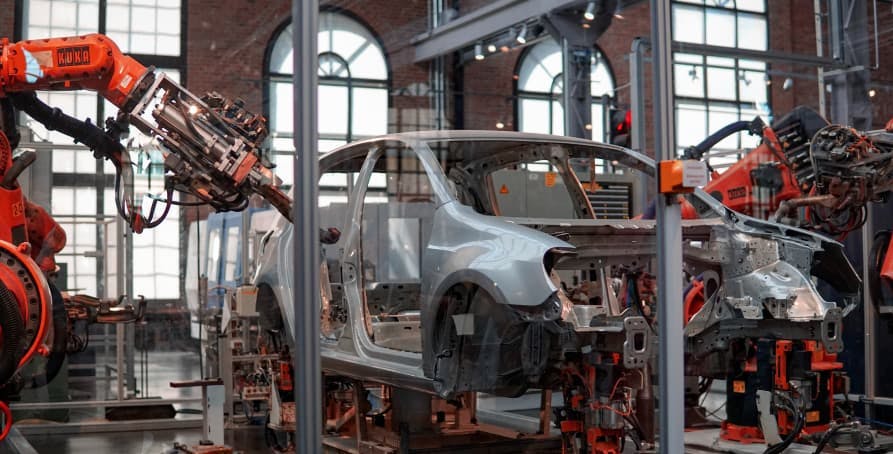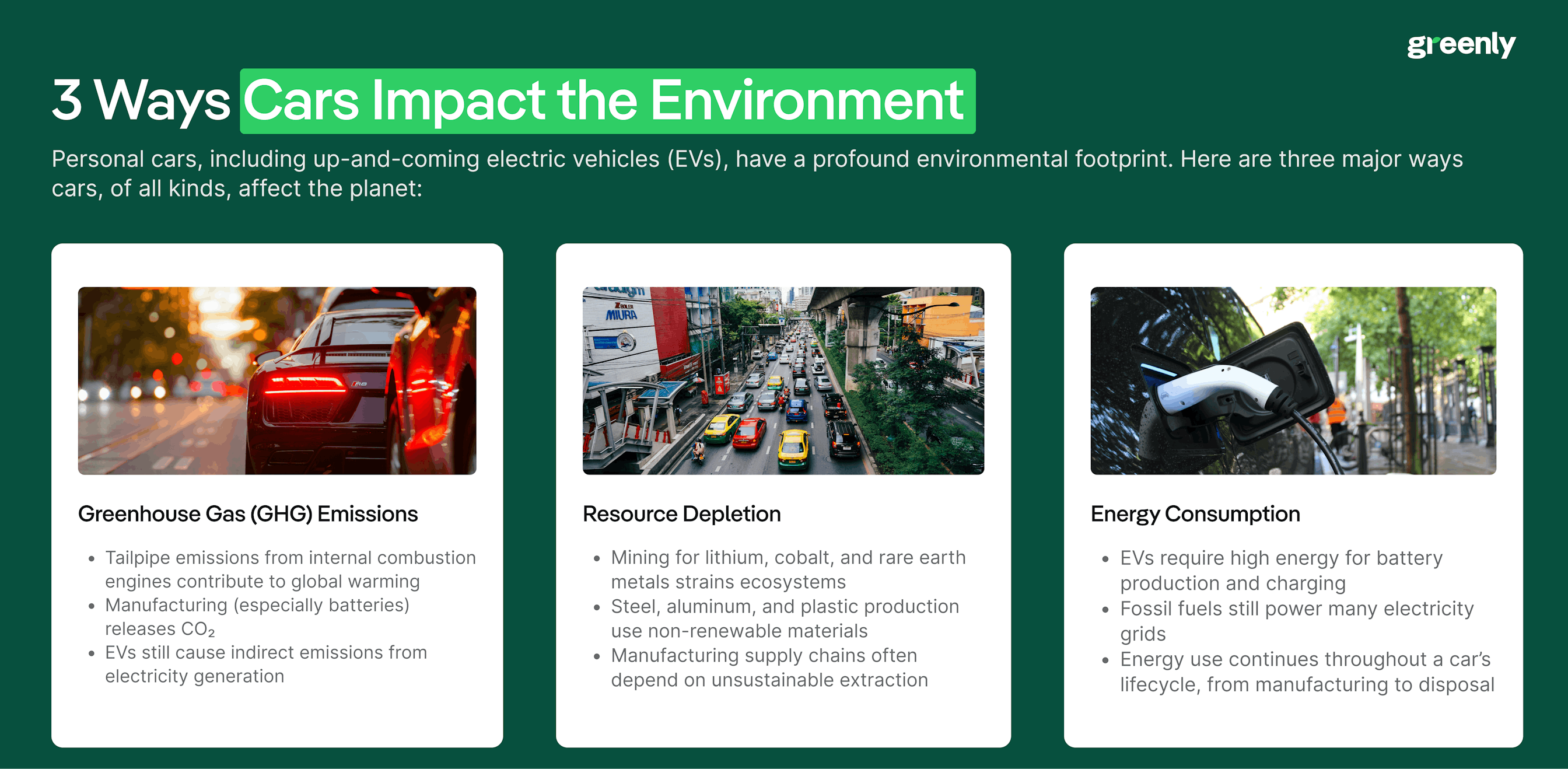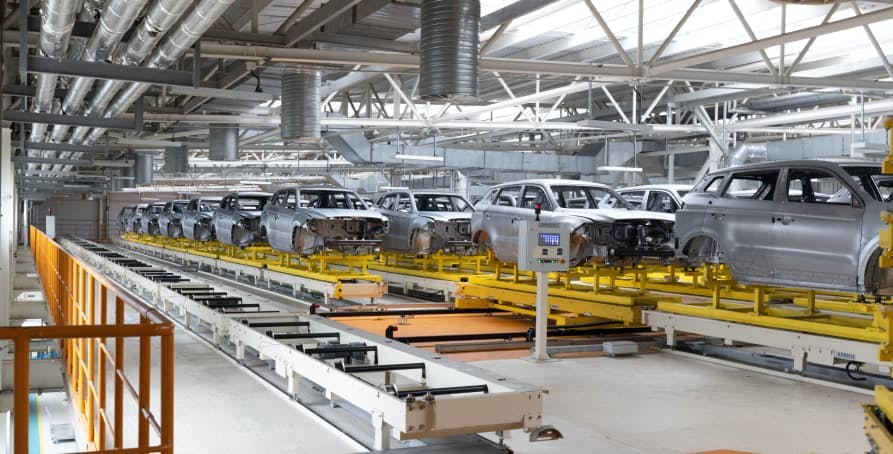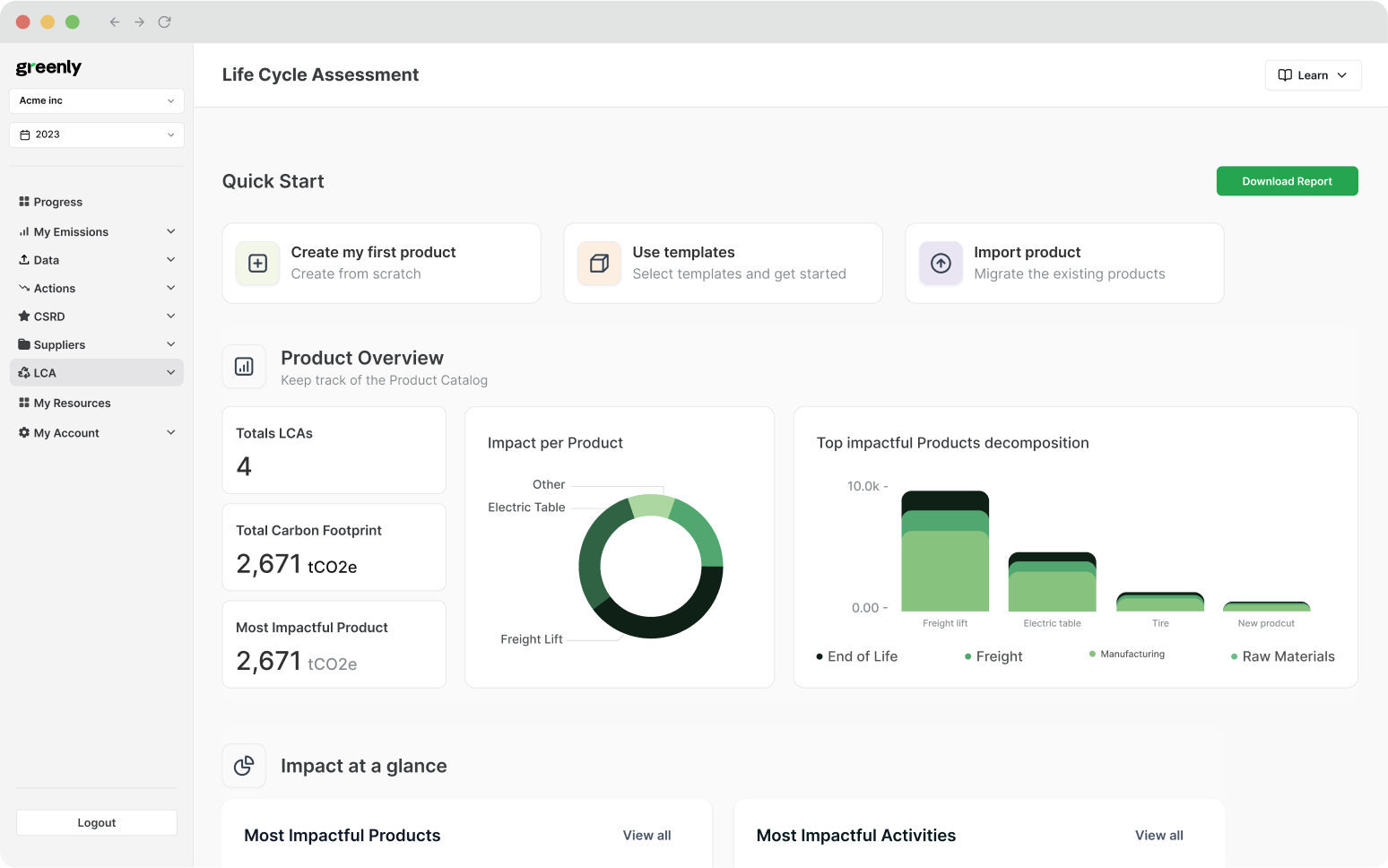ESG / CSR
Industries
What is the LCA of a Car?



- Why car manufacturers and businesses should consider the LCA of a car
- How to calculate the LCA of a car
- How conducting the LCA of a car could help to decarbonize the industry in the future as a whole
Businesses are beginning to recognize the importance of sustainability, and not just for the sake of the planet – but for their own success, such as with the LCA of a car manufactured in the automotive industry.
Cars, motorcycles, and just about anything with an engine you might see on the road – all of these modes of transportation must begin to exercise greater sustainability, seeing as over 80% of Americans alone drive on a frequent basis.
Therefore, it is imperative that the automotive industry seeks to conduct the life-cycle, or LCA of a car with more care and conscious effort. This is in consideration to the current environmental impact this industry has, and will continue to have, on the world.
In this article, we’ll review what a life-cycle assessment is, the LCA of a car, and the future sustainability trends that could emerge from an increase of life-cycle assessments completed for cars.
Recap: What is an LCA?
A life cycle assessment, otherwise more commonly referred to as LCA, is the practice of evaluating the environmental impact of a product or service.
LCAs are conducted in order to better understand how a product or service negatively impacts the environment in the midst of climate change. Therefore, LCAs can be used to help companies and manufacturers alike alter their business models and production habits to be more efficient and eco-friendly.
4 Main Stages of LCA
LCAs are commonly broken down into four main stages:
- Defining the goal and scope of the LCA
- Conducting a Life Cycle Inventory Analysis (LCI)
- Conducting a Life Cycle Impact Assessment (LCIA)
- Interpreting the data provided by the various LCA assessments
The summary cards below will break down the four main stages of LCA:
The first step of an LCA is determining its purpose: what product or service is being assessed, which life cycle stages are included, and the boundaries of the study.
This stage collects data on all energy, material, and emissions flows into and out of the product system — from raw materials to waste.
The LCIA interprets inventory data by evaluating environmental impacts like global warming potential, water use, and resource depletion.
The final stage analyzes the results to draw conclusions, assess uncertainties, and guide decisions for improving sustainability.
LCA with Greenly
Navigating the several stages associated with LCA can be tricky, but luckily – Greenly can help your organization to better manage its LCA.
Check out our LCA product tour video below for a sneak-peak at what our platform entails.
Book a free demo with us today to learn how we can make LCA easier than ever before!
Why Do Car Manufacturers Benefit from LCA?
One of the entities that will benefit the most from the LCA of a car is manufacturers, and seeing as a hefty part of the carbon emissions from the car industry comes from manufacturing itself. This means that LCAs can largely influence product design, how waste is disposed, and inspire changes in the manufacturing process to improve energy efficiency and reduce a facility’s carbon footprint.
The drop down sections below will expand upon these reasons to conduct the LCA of a car:
✏️ Improved product design
LCAs give manufacturers insights into the full environmental impact of a car, from materials to end-of-life, helping them design more sustainable and efficient products.
🗘️ Waste disposal
By understanding a car's end-of-life phase, LCAs can guide better recycling strategies and material reuse, reducing the burden on landfills and ecosystems.
🔋 Improve energy efficiency
LCAs reveal which production stages consume the most energy, helping manufacturers improve operations and machinery to minimize energy use.
❄️ Reduce carbon footprint
By pinpointing emissions across the car's life cycle, LCAs help manufacturers adopt cleaner materials, greener logistics, and more responsible production practices.
Conducting a life-cycle assessment, especially the LCA of a car (which is a high emitting vehicle and activity), can ultimately help us to get a better understanding of the current environmental impact a product creates – and give us insight and incentive to improve the product to fit our newfound world transitioning to sustainability.



Why is the LCA of a Car Important?
The life cycle of a car is imperative for us to understand and rectify considering that automobile usage is still high in countries such as the United States, and serves as the primary mode of transportation for the majority of people.
In fact, over two thirds of Americans still opt for their car in their daily commutes – with over 76% of Americans using a personal vehicle to get to and from work, according to the the Statista's Global Consumer Survey.
Did you know? Transportation accounted for 29% of greenhouse gas emissions in the U.S. in 2021, which is only bound to increase given the resumption of normal activities and travel following the pandemic.
Importance of Cars in Daily Life
Think about which is more important to have in your day-to-day life – a working watch, or smartphone. Odds are, your answer is going to be a smartphone, because that is the device you use more frequently.
The same goes for cars, and seeing as their environmental impact remains massive – it is important for us to understand the life-cycle of a car in order to effectively reduce the environmental impact cars could continue to have in the future.
The overview cards below will reveal why car usage is still high, even in the age of decarbonization and greater awareness of climate change:
Convenience
Driving lets people leave anytime — no need to rely on schedules or wait for transit.
Road Trips
Cars remain the easiest way to reach remote or scenic spots that transit doesn’t serve.
Limited Transit Options
In many regions, public transport is still underdeveloped, making cars the norm.
Personal Comfort
Cars offer climate control, quiet, and privacy — features transit has yet to master.
Car-Centered Cities
Urban sprawl and suburban layouts often require a car to access stores, work, or services.
Family & Errands
For parents or multi-stop days, using a car is more efficient and manageable than public transit.
Importance of LCA with Continued High Usage of Personal Vehicles
A few other reasons why the LCA of a car is important include:
- Better Future Designs – Think of the first iPhone: while it was clunky and had a blurry camera, the iPhone we know and use today wouldn’t have existed without that first model. The same goes for cars, meaning we need to conduct the LCA of a car in order to eventually design and develop improved vehicle models.
- Appropriate Advertising – Everyone wants to avoid greenwashing, and one of the best ways to do that is to ensure a proper LCA is conducted. This ensures that you share relevant information regarding resource and energy usage when advertising your car to potential customers.
- Improved Comparisons Between Cars – Conducting the LCA of a car will allow for improved comparisons between different car models, such as by how the cars were manufactured and the different technologies used. This allows for greater transparency, consumer awareness, and ultimately allows the automotive industry to practice greater sustainability.
- Comply with Environmental Regulations – States such as California have placed a ban on purchasing gasoline-powered cars from 2035 onwards, and while not all states may be this strict – it is viable to presume more stringent regulations on vehicles will come into effect as sustainability begins to be taken more seriously. There, conducting the LCA of a car can help keep automotive manufacturers and companies in check and prevent legal issues.
- Reduce Carbon Footprint of Cars – You can’t reduce what you don’t know. This is essentially why conducting the LCA of a car is so crucial during climate change, as the average user/driver/car owner will not have much control over the greenhouse gas emissions their car produces – leaving the fate of a car’s environmental impact in the hands of the manufacturer.
In short, it’s imperative to conduct the LCA of a car in order to reduce the environmental impact currently created by the automotive industry – as many car manufacturing companies emit 50% more emissions than reported.

How Cars Impact the Planet: A Full Breakdown on the LCA of a Car
The LCA of a car may seem intimidating given the complex nature of the production process for cars, but don’t worry – we’re going to explain the LCA of a car one step at a time.
First off, the life cycle of a car can be broken down into the following stages:
1. Raw Material Extraction and Processing 🌍
This step refers to all of the materials sourced, used, and processed before the manufacturing stage begins. Many of these materials can be recycled, such as glass or certain metals – but other materials sourced to build a car such as plastic, remain a caution for concern regarding the LCA of a car.
2. Manufacturing the Car 🏭
This step refers to the emissions created during the manufacturing process of the car. This often creates a hefty environmental impact seeing as a wide variety of materials are needed to build both the exterior and the interior of a car: such as metals, plastic, glass, cloth, and leather.
3. Vehicle Usage 🚗
This step refers to the emissions created on behalf of the vehicle while it is in use by a consumer. Unlike the first two steps, the data on this step is bound to vary considerably – seeing as it is dependent on how often someone drives and what kind of car model they own. Newer models may be more fuel or energy efficient, but may have more energy intensive smart technologies installed that take up more power as opposed to older models.
4. Disposal or Recycling of the Car ♻️
This refers to how the car is disassembled, disposed, and potentially recycled. However, this component of the LCA of a car is subject to vary once more depending on the car model – and how many recyclable materials were used during production.
Throughout each of these stages, a car creates an environmental impact – such as through excessive greenhouse gas emissions, energy consumption, air pollution, and depleting resources to manufacture the car in the first place.
Life Cycle Assessment (LCA) of a Car: A Breakdown of Environmental Impact
Here is a more comprehensive breakdown of the environmental impact created during each stage throughout the LCA of a car:
- Greenhouse Gas Emissions – Created mostly during the usage and manufacturing phase, cars often emit excessive GHG emissions seeing as many cars still use gasoline to drive and are made in energy-intensive production warehouses.
- Energy Consumption – Predominantly concerning the usage phase of the car, this refers to the amount of energy consumed by the car – such as lithium ion batteries for electric cars or other components of the car that do not require gasoline to function. This could include back-up cameras, lights, or central heating or air conditioning.
- Air Pollution – Once again created during the usage and manufacturing phase, the LCA of a car contributes to excess greenhouse gas emissions which pollute our air and compromise our air quality.
- Resource Depletion – Luckily, 75% of cars today can be recycled – but this still leaves room for the 25% of materials that end up in landfills, which contributes to even more greenhouse gas emissions.
The LCA of a car can help the automotive industry to understand where there cars produce the greatest environmental impact throughout their lifecycle and adjust them to be more sustainable accordingly.



LCA in Car Industry: Benefits and Drawbacks
There are multiple benefits for using an LCA for cars, such as for inspiring improved ecological design and reducing the emissions created by cars both while driving and being produced by the manufacturer.
The main benefit of conducting the LCA of a car is to help the vehicle reduce emissions across the span of its life-cycle, meaning from when it is produced to when the driver actually uses the car.
The LCA of a car is imperative in the midst of climate change, as it can provide the necessary insight manufacturers and other automobile companies need to alter their business models and production lines to be more sustainable and comply with ongoing or future environmental regulations or climate disclosures.
However, there are also several disadvantages to conducting the LCA of a car, such as:
- Unspecified data that may end up being generalized for public consumption, which reduces the accuracy of the information shared regarding the environmental impact cars have on the environment;
- The LCA of a car requires an extensive amount of time, especially seeing as an LCA requires information on the sourcing of raw materials – which can be difficult to pinpoint with something as complex as a car and could compromise the end results of the LCA;
- Each junkyard may follow a different procedure for disposing a car, which again may compromise the LCA of a car.
The battle cards below will further breakdown the benefits and drawbacks of conducting an LCA on a car:
- 🔍 Identifies which stages of a car’s life cycle are most polluting
- 📊 Provides data-driven insights for climate disclosures and decarbonization strategy
- ♻️ Encourages more sustainable design, production, and disposal methods
- 🚗 Helps customers and companies understand full vehicle impact beyond fuel emissions
- ⏱️ Time-intensive process that requires detailed and sometimes inaccessible data
- 💸 Can be costly and difficult to conduct for every car model
- 📉 Results vary based on assumptions and system boundaries
- ⚙️ Requires specialized knowledge and tools to interpret results effectively
While there are potential challenges and setbacks to remain mindful of when conducting the LCA of a car, it is still worthwhile and important in order to improve the design and ecological functionality of vehicles moving forward.

Emerging Industry Trends Driven by Automotive Life Cycle Assessments
If more automotive companies were to conduct the LCA of a car, we could see more sustainable car designs in the near future – such as cars that make use of smart technology or other resources to improve energy efficiency and reduce emissions.
Multiple new ideas could come to life as a result of conducting the LCA of a car, as the LCA may provide new insights to high-emitting components of car manufacturing that would have otherwise gone unnoticed.
New & Modern Car Features
For example, one of the most popular new features for cars today is an automatic engine – which turns on and off by itself as intelligent sensors see fit for the driver. This feature would have likely never been installed if there wasn’t a greater push to reduce greenhouse gas emissions, and it is probable that future sustainable designs will be born out of conducting an LCA of a car.
The interactive flip cards below (move cursor over card to flip) will reveal additional car features that have been developed with sustainability and LCA in mind:
Increased Longevity with LCA in the Automotive Industry
The LCA of a car may also inspire people to keep their cars for longer periods of time, which may include more frequent trips to the mechanic to ensure their car stays in tip-top shape. This commitment is ultimately less energy intensive than disposing of an old car and purchasing a new or even used car.
Encouraging New Modes of Transportation
Conducting the LCA of a car hasn’t only inspired new eco-friendly innovations for car manufacturers, but for other modes of transportation as well. For instance, these days – almost everyone in big cities has made use of a bike or scooter ride-share app for everyday use to avoid needing to drive a car or use public transportation.
In fact, young Europeans are in support of banning the sale of petrol and diesel cars to help curb the existing environmental impact of the automotive industry – with 46% of 18- to 24-year-olds in support of this notion.
The overview cards below will reveal some of the alternative ways young people are looking to get around:
The increased importance of the LCA of a car may also continue to inspire more intense legislation, such as the gasoline-powered car ban depicted in California’s climate legislation. This will forbid Californian’s from purchasing new fossil fuel-based vehicles from 2035 onwards – further pushing people to get on board with electric vehicles or to make use of public transportation.
Overall, conducting the LCA of a car will not only help to inspire new ecological designs for vehicles of all kinds – but will help to reinforce the importance of sustainability in our warming world. There has never been a better time to conduct the LCA of a car, or any product or service for that matter, than today.

What About Greenly?
If reading this article about the life cycle, or LCA, of a car has made you interested in reducing your carbon emissions to further fight against climate change – Greenly can help you!
Seeking to understand the life-cycle of your various products and services, and how they may impact your business could be confusing, but don’t worry – Greenly is here to help! Click here to book a demo and get personalized expertise on how you can start to reduce your own emissions and decrease your environmental impact.
Greenly can help you make an environmental change for the better, starting with a carbon footprint assessment to know how much carbon emissions your company produces.






